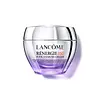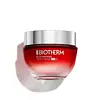What's inside
What's inside
 Key Ingredients
Key Ingredients

 Benefits
Benefits

 Concerns
Concerns

 Ingredients Side-by-side
Ingredients Side-by-side

Water
Skin ConditioningDiisopropyl Sebacate
EmollientDiisopropyl Adipate
EmollientSilica
AbrasiveBis-Ethylhexyloxyphenol Methoxyphenyl Triazine
Skin ConditioningEthylhexyl Triazone
UV AbsorberPropylene Glycol
HumectantButyl Methoxydibenzoylmethane
UV AbsorberAlcohol Denat.
AntimicrobialC12-15 Alkyl Benzoate
AntimicrobialNiacinamide
SmoothingDimethicone
EmollientAluminum Starch Octenylsuccinate
AbsorbentDipropylene Glycol
HumectantStearic Acid
CleansingPotassium Cetyl Phosphate
EmulsifyingBehenyl Alcohol
EmollientMethoxypropylamino Cyclohexenylidene Ethoxyethylcyanoacetate
StabilisingOryza Sativa Cera
Skin ConditioningCI 17200
Cosmetic ColorantCI 42090
Cosmetic ColorantTocopherol
AntioxidantLactobacillus Ferment
Skin ConditioningCyclodextrin
AbsorbentSodium Cocoyl Sarcosinate
CleansingSodium Acetylated Hyaluronate
HumectantSodium Polyacrylate
AbsorbentHydrolyzed Lupine Protein
Skin ConditioningHydrolyzed Linseed Extract
Skin ConditioningSodium Chloride
MaskingSodium Benzoate
MaskingPhenoxyethanol
PreservativeAdenosine
Skin ConditioningPEG-100 Stearate
Triethanolamine
BufferingTrisodium Ethylenediamine Disuccinate
Palmitic Acid
EmollientPentylene Glycol
Skin ConditioningPentaerythrityl Tetra-Di-T-Butyl Hydroxyhydrocinnamate
AntioxidantXanthan Gum
EmulsifyingDrometrizole Trisiloxane
UV AbsorberAcrylates/C10-30 Alkyl Acrylate Crosspolymer
Emulsion StabilisingMyristic Acid
CleansingPisum Sativum Extract
Skin ConditioningGlyceryl Stearate
EmollientParfum
MaskingWater, Diisopropyl Sebacate, Diisopropyl Adipate, Silica, Bis-Ethylhexyloxyphenol Methoxyphenyl Triazine, Ethylhexyl Triazone, Propylene Glycol, Butyl Methoxydibenzoylmethane, Alcohol Denat., C12-15 Alkyl Benzoate, Niacinamide, Dimethicone, Aluminum Starch Octenylsuccinate, Dipropylene Glycol, Stearic Acid, Potassium Cetyl Phosphate, Behenyl Alcohol, Methoxypropylamino Cyclohexenylidene Ethoxyethylcyanoacetate, Oryza Sativa Cera, CI 17200, CI 42090, Tocopherol, Lactobacillus Ferment, Cyclodextrin, Sodium Cocoyl Sarcosinate, Sodium Acetylated Hyaluronate, Sodium Polyacrylate, Hydrolyzed Lupine Protein, Hydrolyzed Linseed Extract, Sodium Chloride, Sodium Benzoate, Phenoxyethanol, Adenosine, PEG-100 Stearate, Triethanolamine, Trisodium Ethylenediamine Disuccinate, Palmitic Acid, Pentylene Glycol, Pentaerythrityl Tetra-Di-T-Butyl Hydroxyhydrocinnamate, Xanthan Gum, Drometrizole Trisiloxane, Acrylates/C10-30 Alkyl Acrylate Crosspolymer, Myristic Acid, Pisum Sativum Extract, Glyceryl Stearate, Parfum
Water
Skin ConditioningGlycerin
HumectantDiisopropyl Sebacate
EmollientIsopropyl Myristate
EmollientPropanediol
SolventDrometrizole Trisiloxane
UV AbsorberBis-Ethylhexyloxyphenol Methoxyphenyl Triazine
Skin ConditioningPentylene Glycol
Skin ConditioningEthylhexyl Triazone
UV AbsorberC12-15 Alkyl Benzoate
AntimicrobialPolyglyceryl-6 Distearate
EmulsifyingCetyl Esters
EmollientButyl Methoxydibenzoylmethane
UV AbsorberOryza Sativa Cera
Skin ConditioningJojoba Esters
EmollientBehenyl Alcohol
EmollientAcrylamide/Sodium Acryloyldimethyltaurate Copolymer
Emulsion StabilisingAcacia Decurrens Flower Cera
EmollientHelianthus Annuus Seed Cera
EmollientSorbitan Oleate
EmulsifyingIsohexadecane
EmollientSodium Hyaluronate
HumectantSodium Lactate
BufferingSodium Stearoyl Glutamate
CleansingPalmitoyl Tetrapeptide-7
Skin ConditioningPalmitoyl Tripeptide-1
Skin ConditioningHydroxyacetophenone
AntioxidantHydroxypropyl Starch Phosphate
Caprylyl Glycol
EmollientVitreoscilla Ferment
Skin ConditioningTrisodium Ethylenediamine Disuccinate
Xanthan Gum
EmulsifyingPolyglycerin-3
HumectantPolyglyceryl-3 Beeswax
EmulsifyingPolysorbate 80
EmulsifyingCetyl Alcohol
EmollientTocopherol
AntioxidantChlorphenesin
AntimicrobialCI 14700
Cosmetic ColorantCI 19140
Cosmetic ColorantParfum
MaskingWater, Glycerin, Diisopropyl Sebacate, Isopropyl Myristate, Propanediol, Drometrizole Trisiloxane, Bis-Ethylhexyloxyphenol Methoxyphenyl Triazine, Pentylene Glycol, Ethylhexyl Triazone, C12-15 Alkyl Benzoate, Polyglyceryl-6 Distearate, Cetyl Esters, Butyl Methoxydibenzoylmethane, Oryza Sativa Cera, Jojoba Esters, Behenyl Alcohol, Acrylamide/Sodium Acryloyldimethyltaurate Copolymer, Acacia Decurrens Flower Cera, Helianthus Annuus Seed Cera, Sorbitan Oleate, Isohexadecane, Sodium Hyaluronate, Sodium Lactate, Sodium Stearoyl Glutamate, Palmitoyl Tetrapeptide-7, Palmitoyl Tripeptide-1, Hydroxyacetophenone, Hydroxypropyl Starch Phosphate, Caprylyl Glycol, Vitreoscilla Ferment, Trisodium Ethylenediamine Disuccinate, Xanthan Gum, Polyglycerin-3, Polyglyceryl-3 Beeswax, Polysorbate 80, Cetyl Alcohol, Tocopherol, Chlorphenesin, CI 14700, CI 19140, Parfum
Ingredients Explained
These ingredients are found in both products.
Ingredients higher up in an ingredient list are typically present in a larger amount.
Behenyl Alcohol is a type of fatty alcohol (these are different from the drying, solvent alcohols).
Fatty Alcohols have hydrating properties and are most often used as an emollient or to thicken a product. They are usually derived from natural fats and oils; behenyl alcohol is derived from the fats of vegetable oils.
Emollients help keep your skin soft and hydrated by creating a film that traps moisture in.
In 2000, Behenyl Alcohol was approved by the US as medicine to reduce the duration of cold sores.
Learn more about Behenyl AlcoholYou might know this ingredient as Tinosorb S or Bemotrizinol. It is a UV filter that covers both UVA and UVB rays.
This ingredient has two peak UV absorption peaks ( 310 and 340 nm) and is able to absorb both UV-A and UV-B rays. This ingredient works by preventing UV rays from reaching and damaging your skin.
On top of that - it is highly photostable and helps prevent the photodegration of other sunscreen ingredients such as avobenzone.
Tinosorb S is allowed in the EU, Australia, and Asia. It is close to being approved by the FDA and we'll hopefully get this ingredient in the U.S. by late 2025.
Fun fact: Tinosorb S is the most effective UV absorber at maximum concentration (measured by SPF) permitted in the EU.
This ingredient is oil-soluble, so your oil-cleansers will take this right off at night.
Learn more about Bis-Ethylhexyloxyphenol Methoxyphenyl TriazineAlso known as Avobenzone, this ingredient is a chemical sunscreen filter that provides protection in the UV-A range.
Avobenzone is globally approved and is the most commonly used UV-A filter in the world.
Studies have found that avobenzone becomes ineffective when exposed to UV light (it is not photostable; meaning that it breaks down in sunlight). Because of this, formulations that include avobenzone will usually contain stabilizers such as octocrylene.
However, some modern formulations (looking at you, EU!) are able to stabilize avobenzone by coating the molecules.
Avobenzone does not protect against the UV-B range, so it's important to check that the sunscreen you're using contains other UV filters that do!
The highest concentration of avobenzone permitted is 3% in the US, and 5% in the EU.
Learn more about Butyl MethoxydibenzoylmethaneC12-15 Alkyl Benzoate is made up of Benzoic Acid and long chain alcohols. It has a low molecular weight.
C12-15 Alkyl Benzoate is an emollient and texture enhancer. Due to its solubility, it is often used in sunscreens to help evenly distribute active ingredients.
As an emollient, C12-15 Alkyl Benzoate helps soften and hydrate your skin. Emollients create a film on your skin that traps moisture within.
This ingredient has been reported to cause eye irritation.
Learn more about C12-15 Alkyl BenzoateWe don't have a description for Diisopropyl Sebacate yet.
Drometrizole Trisiloxane is a UV filter that provides both UV-A (344 nm) and UV-B (303 nm) protection.
This ingredient is photostable and studies show it to be generally safe and effective. The compound Meroxyl XL is owned by L'Oreal while Drometrizole trisiloxane can be found in other sunscreen brands.
It is currently approved for use in the EU, Canada, Australia, and Japan. However, it is not yet approved for use in the US.
This ingredient is often used with other sunscreen ingredients, such as Ecamsule.
Learn more about Drometrizole TrisiloxaneEthylhexyl Triazone is a modern chemical sunscreen that protects from UV-B radiation.
It is the most effective of existing UV-B filters, as it provides the highest level of photo-stable absorption. It protects from the entire UV-B range (280 to 320nm), with it's highest level of protection at 314nm.
Ethylhexyl Triazone is oil soluble, oderless and colorless, which mean it is able to be incorporated into a variety of different formulations.
It is not currently available within the United States due to slow changing FDA regulations. Outside of the US, it is used in formulations at concentrations up to 5%.
Learn more about Ethylhexyl TriazoneWe don't have a description for Oryza Sativa Cera yet.
Parfum is a catch-all term for an ingredient or more that is used to give a scent to products.
Also called "fragrance", this ingredient can be a blend of hundreds of chemicals or plant oils. This means every product with "fragrance" or "parfum" in the ingredients list is a different mixture.
For instance, Habanolide is a proprietary trade name for a specific aroma chemical. When used as a fragrance ingredient in cosmetics, most aroma chemicals fall under the broad labeling category of “FRAGRANCE” or “PARFUM” according to EU and US regulations.
The term 'parfum' or 'fragrance' is not regulated in many countries. In many cases, it is up to the brand to define this term.
For instance, many brands choose to label themselves as "fragrance-free" because they are not using synthetic fragrances. However, their products may still contain ingredients such as essential oils that are considered a fragrance by INCI standards.
One example is Calendula flower extract. Calendula is an essential oil that still imparts a scent or 'fragrance'.
Depending on the blend, the ingredients in the mixture can cause allergies and sensitivities on the skin. Some ingredients that are known EU allergens include linalool and citronellol.
Parfum can also be used to mask or cover an unpleasant scent.
The bottom line is: not all fragrances/parfum/ingredients are created equally. If you are worried about fragrances, we recommend taking a closer look at an ingredient. And of course, we always recommend speaking with a professional.
Learn more about ParfumPentylene glycol is typically used within a product to thicken it. It also adds a smooth, soft, and moisturizing feel to the product. It is naturally found in plants such as sugar beets.
The hydrophilic trait of Pentylene Glycol makes it a humectant. As a humectant, Pentylene Glycol helps draw moisture from the air to your skin. This can help keep your skin hydrated.
This property also makes Pentylene Glycol a great texture enhancer. It can also help thicken or stabilize a product.
Pentylene Glycol also acts as a mild preservative and helps to keep a product microbe-free.
Some people may experience mild eye and skin irritation from Pentylene Glycol. We always recommend speaking with a professional about using this ingredient in your routine.
Pentylene Glycol has a low molecular weight and is part of the 1,2-glycol family.
Learn more about Pentylene GlycolTocopherol (also known as Vitamin E) is a common antioxidant used to help protect the skin from free-radicals and strengthen the skin barrier. It's also fat soluble - this means our skin is great at absorbing it.
Vitamin E also helps keep your natural skin lipids healthy. Your lipid skin barrier naturally consists of lipids, ceramides, and fatty acids. Vitamin E offers extra protection for your skin’s lipid barrier, keeping your skin healthy and nourished.
Another benefit is a bit of UV protection. Vitamin E helps reduce the damage caused by UVB rays. (It should not replace your sunscreen). Combining it with Vitamin C can decrease sunburned cells and hyperpigmentation after UV exposure.
You might have noticed Vitamin E + C often paired together. This is because it is great at stabilizing Vitamin C. Using the two together helps increase the effectiveness of both ingredients.
There are often claims that Vitamin E can reduce/prevent scarring, but these claims haven't been confirmed by scientific research.
Learn more about TocopherolTrisodium Ethylenediamine Disuccinate is used to help stabilize a product.
It is a chelating agent, meaning it helps prevent metal ions from binding to other ingredients. This prevents unwanted reactions in products. Metal ions can come into a product via the water ingredient. They are found in trace amounts and are not known to be harmful.
Water. It's the most common cosmetic ingredient of all. You'll usually see it at the top of ingredient lists, meaning that it makes up the largest part of the product.
So why is it so popular? Water most often acts as a solvent - this means that it helps dissolve other ingredients into the formulation.
You'll also recognize water as that liquid we all need to stay alive. If you see this, drink a glass of water. Stay hydrated!
Learn more about WaterXanthan gum is used as a stabilizer and thickener within cosmetic products. It helps give products a sticky, thick feeling - preventing them from being too runny.
On the technical side of things, xanthan gum is a polysaccharide - a combination consisting of multiple sugar molecules bonded together.
Xanthan gum is a pretty common and great ingredient. It is a natural, non-toxic, non-irritating ingredient that is also commonly used in food products.
Learn more about Xanthan Gum